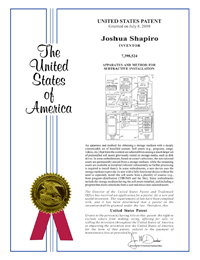
What it is
How it works
Why it's better
How it's used
Who would use it
Calling Michael Dell
Calling Steve Jobs
Who will win
Why it's timely
Green credentials
How much would it cost
Frequently Asked Questions
Give me the details
And there's more
Patents pending
To learn more
|

|
Every 100GB of storage can act as a repository for either 300 substantial software programs, 35,000 mp3 tracks, 300 books, 100 feature films, or 450 half hour television episodes. In terms of value density, that 100GB can hold $60,000 of software, $35,000 of music, $6000 of books, $1,500 of movies, or $900 of television.
A personal computer, laptop or desktop, in 2009, has an average 200GB of disk drive storage at a cost of about $50. But looking ahead, let’s assume a 300GB average at about $80 dollars each.
Capital equipment to pump out 10 million imaged 300GB drives a year is roughly a one million dollar, one-time, pre-tax capital expenditure. Using Dell as a metric, this manufacturing volume represents over a quarter of Dell’s annual worldwide PC output.
Assuming no automation, twenty headcount could operate the equipment. Running 3 shifts x 365 days in Mexico, China, India or other low labor cost location would cost $175,000 annually in labor.
To build the panoplex while still writing off complete equipment depreciation in the first year, though not accounting for rent and power, would be 11.8¢ per drive. This would go to zero if the drive manufacturer (eg Seagate) duplicates the images instead of an OEM or EDS, like Dell or Flextronics.
Time to erase the drives is variable (depending on mix of mp3, mpeg, software) but 6 cents a drive is a fair guess.
If you add costs for the integration with the GUI and supply chain, power (2.5WH/drive) and rent (2000 sq ft), the cost of the sideloading method probably comes in under 20-25¢ per drive all in. With a drive costing $80, the expense of adding software sideloading ought to be noise in the cost equation.
Assuming sideloading drives purchase of five new forty dollar programs from a catalog of over nine hundred, a $200 delta software sale (reasonable even on a $499 value PC) at 40% margins, the upside is booking about $80 in revenue per unit against sub dollar costs.
On 10 million drives, this would be an extra $800M/yr in profit. To put it another way, this moderate sale more than doubles average profit per unit and likewise ought to double share price.
To the downside, even with only a $10 software delta, with a razor thin 10% margin, one makes money. A manufacturer would need to sell enough digital assets with a minimum margin of $11 to supplant displaced revenue from the current practice of renting out the desktop as an advertising medium for crapware. |